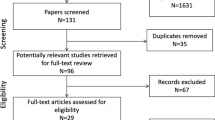Abstract
On the basis of investigating author's opinion on citing motivations of chemistry papers aquasi-quantitative model for citing is suggested. The model selects professional and nonprofessional motivations of citing and introduces thecitation threshold concept which tries to characterize the effect of citing motivations quantitatively. Possible reasons for missing citations are also treated. Mean ages of real and of self-citations were calculated by subtracting the average of the publication years of cited papers from the publication year of the citing publication. The difference between the mean ages may characterize thesynchronity of the author's research in comparison with those working on similar topics. The paper introduces thecitation strategy indicator which relates impact factors of cited periodicals with the mean impact factor of periodicals in the corresponding research subfield.
Similar content being viewed by others
References
E. GARFIELD,Citation Indexing-Its Theory and Application in Science, Technology and Wiley, New York, 1979.
B. CRONIN,The Citation Process, Taylor Graham, London, 1984.
A. L. PORTER, Citation analysis: queries and caveats,Social Studies of Sciences, 7 (1977) 257.
J. R. RAVETZ,Scientific Knowledge and its Social Problems, Clarendon Press, Oxford, 1971.
D. DE SOLLA PRICE,Little Science-Big Science, Columbia University Press, New York and London, 4th Ed., 1971.
S. M. LAWANI, A. E. BAYER, Validity of citation criteria for assessing the influence of scientific publications; new evidence with peer assessment,Journal of the Americal Society for Information Science, 31 (1983) 59.
N. KAPLAN, The norms of citation behaviour: prolegomena to the footnote,American Documentation, 16 (1965) 179.
R. K. MERTON, Insiders and outsiders: a chapter in the sociology of science,American Journal of Sociology, 78 (1972) 9.
K. O. MAY, Abuses of citation indexing,Science, 156 (1967) 890.
R. N. BRODAUS, An investigation of the validity of bibliographic citations,Journal of the American Society for Information Science, 34 (1983) 132.
B. C. PERITZ, A classification of citation roles for the social sciences and related fields,Scientometrics, 5 (1983) 303.
M. J. MORAVCSIK, P. MURUGESAN, Some results on the function and quality of citation,Social Studies of Science, 5 (1975) 86–92.
D. EDGE, Quantitative measures of communication in science: A critical review,History of Science, 17 (1979) 102.
C. OPPENHEIM, S. P. RENN, Highly cited old papers and the reasons why they continue to be cited,Journal of the American Society for Information Science, 24 (1978) 225.
B. CRONIN, Norms and functions in citation: the view of journal editors and referees in psychology,Social Science Information Studies, 2 (1982) 65.
T. A. BROOKS, Evidence of complex citer motivations,Journal of the American Society for Information Science, 37 (1986) 34.
B. R. MARTIN, J. IRVINE, CERN: Past performance and future proscpects I.,Research Policy, 13 (1984) 186.
P. VINKLER, Management system for a scientific research institute based on the assessment of scientific publications,Research Policy, 15 (1986) 77.
P. VINKLER, A quasi-quantitative citation model for natural science papers,Kutatás-Fejlesztés, (1986) 250. (in Hungarian).
B. C. GRIFFITH, P. N. SERVI, A. L. ANKER, M. C. DROTT, The aging of scientific literature: a citation analysis,Journal of Documentation, 35 (1979) 179.
N. PRAVDIČ, R. PEKORARI, The citing practices of the authors to the national journals in mathematics, physics and chemistry,Scientometrics, 8 (1985) 233.
R. E. BURTON, R. W. KEBLER, The “half life” of some scientific and technical literatures,American Documentation, 9 (1960) 18.
P. VINKLER, Evaluation of some methods for the relative assessment of scientific publications,Scientometrics, 10 (1986) 157.
T. BRAUN, J. I. NAGY, A comparative evaluation of some Hungarian and other national biology, chemistry, mathematics and physics journals,Scientometrics, 4 (1982) 439.
J. COLE, S. COLE, Measuring the quality of sociological research: problems in the use of the science citation index,The American Sociologist, 6 (1981) 23.
M. WEINSTOCK, Citation indexes,Encyclopaedia of Library and Information Science, 5 (1971) 16.
J. B. BAVELAS, The social psychology of citations,Canadian Psychological Review, 19 (1978) 158.
J. S. GHOSH, M. L. NEUFELD, Uncitedness of articles in the Journal of the American Chemical Society,Information Storage Retrieval, 10 (1974) 365.
E. GARFIELD, The “obliteration phenomenon” in science and the advantage of being obliterated,Current Contents, 51–52 (1975) 5.
P. M. RENTZEPIS, Direct measurements of radiationless transitions in liquids,Chemistry and Physics Letters, 2 (1968) 117
P. CHUBIN, S. D. MOITRA, Content analysis of references: adjunct or alternative to citation counting?Social Studies of Science, 5 (1975) 423.
F. C. THORN, The citation index: another case of spurious validity,Journal of Clinical Psychology, 33 (1977) 1157.
J. J. J. CHRISTENSEN-SZALANSKI, L. R. BEACH, The citation bias: fad and fashion in the judgement and decision literature,American Psychologist, 39 (1984) 75.
M. POLÁNYI, The logic of tacit inference,Journal of the Royal Institute of Philosophy, 41 (1966) 1.
P. VINKLER, Some relative and partial publication indicators derived from bibliographic data of natural science papers,Kutatás-Fejlesztés, 1987 (in press) (in Hungarian).
Author information
Authors and Affiliations
Rights and permissions
About this article
Cite this article
Vinkler, P. A quasi-quantitative citation model. Scientometrics 12, 47–72 (1987). https://doi.org/10.1007/BF02016689
Received:
Revised:
Issue Date:
DOI: https://doi.org/10.1007/BF02016689



